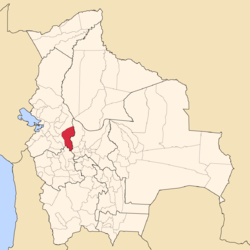Ichoca | |
|---|---|
Town | |
 | |
| Coordinates: 17°09′S67°11′W / 17.150°S 67.183°W | |
| Country | |
| Department | La Paz Department |
| Province | Inquisivi Province |
| Municipality | Ichoca Municipality |
| Population (2001) [1] | |
• Total | 517 |
| Time zone | UTC-4 (BOT) |
Ichoca is a location in the La Paz Department in Bolivia. It is the seat of the Ichoca Municipality, the fifth municipal section of the Inquisivi Province.

